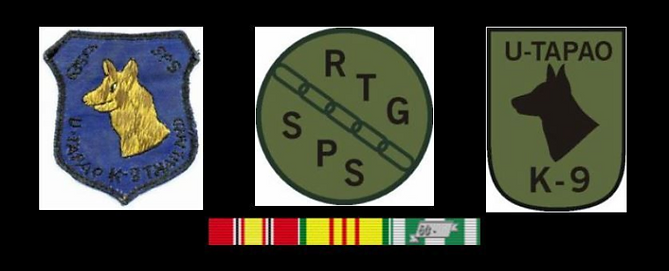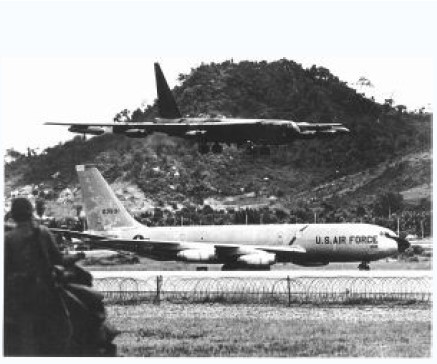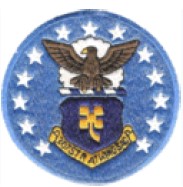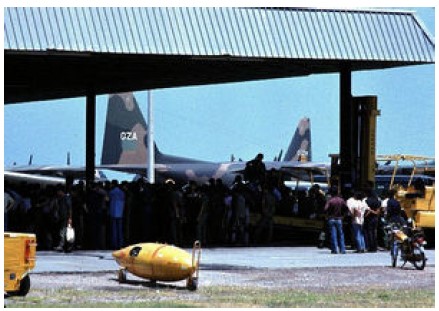635th SPS - U-Tapao Royal Thai Air Force Base

Historical Brief
U-Tapao Royal Thai Navy Airfield was a front-line base of the United States Air Force. The facility is located near the city of Sattahip on the Gulf of Siam, approximately 90 miles south of Bangkok.
USAF Use during the Vietnam War - USAF Strategic Air Command KC-135 tanker and B-52 bomber at U-Tapao Royal Thai Navy Airfield

U-Tapao was an important forward operating base for the United States Air Force (USAF) during the Vietnam War.
Prior to 1965, U-Tapao was a small Royal Thai Navy airfield. At Dong Muang Air Base near Bangkok, the USAF had stationed KC-135 air refueling tankers from Strategic Air Command (SAC) for refueling tactical combat aircraft over the skies of Indochina. Thailand was officially neutral in the Vietnam War and the visibility of the large USAF Boeing tankers in its capital was causing political embarrassment to the Thai government.
The USAF 7th Air Force wanted to have additional KC-135's in Thailand and the solution reached was to expand the Naval airfield at U-Tapao and base the tankers there. Expansion of U-Tapao began in October 1965, with the completed new facility opening at the end of 1967. The 11,000-foot runway became operational on 6 July 1966. U-Tapao received its first complement of USAF Strategic Air Command (SAC) KC-135 tankers in August 1966. By September, the base was supporting 15 tankers. The 4258th Strategic Wing (SAC) was activated in June 1966 at U-Tapao under the 3rd Air Division, Andersen AFB, Guam. The wing was initially charged with the responsibility of supporting refueling requirements of USAF fighter aircraft in Southeast Asia. Later, a second mission of hosting B-52 strategic bombers was added, and these aircraft conducted bombing missions over Indochina on a daily basis from U-Tapao.
USAF Strategic Bombers

By the end of September 1966, SAC B-52 bombers were flying about 430 missions a month over targets in Indochina from Andersen AFB, Guam. The USAF wanted to increase this to 600/month by 1 November and 840/month by January 1967.
To increase this rate, additional B-52's were deployed to Kadena AB, Okinawa. However, these bases were far from Vietnam. Plans were made to relocate the B-52's to the Philippines or Taiwan, but these plans were rejected due to political sensitivity.
The best solution was to base the B-52's in South Vietnam or in Thailand. The cost to upgrade an existing Vietnamese Air Base was high, and the security questions were also troubling. U-Tapao had an existing runway suitable for the bombers, and the cost for upgrades to the base was minimal.
In January 1967, negotiations between the Americans and Thai government started to base them at U-Tapao. The agreement, reached on 2 March 1967, allowed 15 bombers and their support personnel to be based at U-Tapao, with the provision that missions flown from Thailand would not overfly Laos or Cambodia on their way to their targets in Vietnam.
The first B-52's arrived on 10 April 1967. The very next day, B-52 operations were initiated at U-Tapao.
Operation Arc Light
Operation Arc Light was the 1965 deployment of B-52 heavy bombers to Guam. The B-52 bombers were directed at:
- Targets in South Vietnam not requiring deep penetration of Laos, Cambodia, or North Vietnam.
- Targets in North Vietnam that were approved by Washington 24 hours in advance.
- Targets in eastern Laos with the approval of CINCPAC, CINCSAC, and the U.S. Ambassador to Laos.
- Targets in the remainder of Laos that were approved by Washington 24 hours in advance.
By 1969, about 65 percent of all Arc Light sorties would originate from U-Tapao. In 1972, there were 54 B-52 aircraft stationed in Thailand, with missions commonly flown in three-plane formations known as "cells". B-52's were also employed in a tactical role when ground units in Vietnam in heavy combat requested fire support.
Arc Light missions continued until the cessation of hostilities by all U.S. forces on 15 August 1973. At the peak of operations in 1969, the units assigned to U-Tapao RTNF were the following:
- Host Unit - 635th Combat Support Group
- 4258th Strategic Wing - 36 B-52Ds, 14 KC-135s
- Det 12, 38th Air Rescue and Recovery Squadron (ARRS) - 2 HH-43s
On 1 April 1970, in conjunction with the redesignation of the 3rd Air Division, Anderson AFB, Guam, as the Eighth Air Force, the 4258th SW was redesignated as the 307th Strategic Wing.
On 1 June 1972, the 307th SW was reorganized into the 17th Air Division (Provisional), the 310th Strategic Wing (Provisional).
Other missions of USAF at the U-Tapao included supplying other U.S. occupied Thai installations with equipment and materiel; support of the U.S. Army, Navy, and Coast Guard units in the area; and jurisdiction for what has become known as the Sattahip complex. This complex included a nine-berth deep water port, a Coast Guard LORAN station, three U.S. transportation units, and approximately 10,000 American servicemen and Thai nationals.
Operation Linebacker II

Operation Linebacker II was a United States military operation during the Vietnam War. Sometimes referred to as the "Christmas Bombings" or "The Eleven Day War" by aircrews, the operation in late December 1972 had the heaviest bomber strikes of the war, ordered by U.S. President Nixon against targets in North Vietnam. Operation Linebacker II was a resumption of the Linebacker bombings conducted from May to October, except that the emphasis would be on massive attacks by B-52s rather than fighter aircraft.
At U-Tapao, 54 B-52s were engaged in Linebacker II. The U-Tapao force had suffered the first loss of a B-52 to a Surface-to-Air Missile (SAM) in November and had had two others damaged by SAM hits. On 26 December 1972, two of U-Tapao's B-52s turned back for mechanical reasons but their cells continued the mission. As a consequence, a B-52 in each cell was lost, including one that crash-landed at the base, killing most of its crew.
South Vietnamese Collapse
In the two years since the 1973 Paris Peace Accords and the War Powers Act, the North Vietnamese army underwent a massive rebuilding to recoup the losses suffered during the failed 1972 Easter Offensive. By the spring of 1975, the North Vietnamese Army had grown to be the fifth largest in the world and in late December 1974 had begun their drive towards Saigon. By the end of March 1975, North Vietnamese troops had taken over several key cities, either because the ARVN forces were under-equipped and undermanned or because they had fled from the approaching enemy.

Two SVN Air Force C-130As, most likely belonging to the 433rd Transport Squadron (the 435th had tailcodes in the Hxx range) on the tarmac at Royal Thai Navy Airfield - April 1976
By the second week of April, the situation had deteriorated to the point that most of South Vietnam was under the control of the North Vietnamese Army. A Congressional delegation had visited South Vietnam and was unable to convince President Ford to provide more aid. President Ford stated in a speech on April 23 that the Vietnam War "was finished".
An estimated 8,000 U.S. and third-country nationals needed to be evacuated from Saigon and the shrinking government-controlled region of South Vietnam, along with thousands of Vietnamese who had worked for the United States during the war, who would be in dire straits under the Communists. The evacuation of Saigon was code-named Talon Vice.
It called for the evacuation of personnel via commercial aircraft from Tan Son Nhut Air Base and other locations. The plan called for the ARVN to provide crowd control and to secure the evacuation areas. However, as the situation deteriorated rapidly in South Vietnam, the plan was changed to use rooftops as helicopter landing pads for evacuating personnel.
The evacuation plans were completed by 18 April, and the name was changed to Frequent Wind.
U-Tapao Airfield was used as a jumping-off point by the USAF with eight CH-53 and two HH-53 "Sea Stallion" helicopters. Additional helicopters were standing by on board the USS Midway, Nakhon Phanom, and Ubon air bases. Korat placed a force of F-4's, A-7's, and AC-130's on alert. Udorn discontinued its training flights and put its F-4 fighters on alert for combat missions over South Vietnam to support the evacuation.
On 25 April South Vietnamese President Thieu fled the country, and the final collapse of the South Vietnamese government was imminent. Aircraft started to arrive at U-Tapao in South Vietnamese markings. They arrived all that day and the next several days. C-119's, C-130's, C-47's were filled to capacity with men, women and children. After their arrival, the Vietnamese were sequestered in tents near the runway. The adjacent parking ramps and grassy areas were being filled to capacity with South Vietnamese helicopters and aircraft, including many F-5E/F aircraft which were just delivered to South Vietnam in the previous few months.
By 29 April the North Vietnamese had brought in Anti-Aircraft Artillery (AAA) and mobile Surface-To- Air Missiles (SAM) to the Saigon area. Mortar and artillery rounds were impacting at Tan Son Nhut Air Base severely disrupting the evacuation activities. United States aircraft were being fired upon and USAF fighters from Korat and Udorn returned fire, knocking out several AAA and SAM batteries to keep the evacuation corridor open.
At the United States Embassy in Saigon, Marine guards shut off the electricity to the elevators and exploded tear gas canisters as they went to the roof to join the evacuees. The last helicopter left the embassy at 7:53 AM.
On 30 April South Vietnam surrendered. A handful of South Vietnamese Air Force aircraft that had been performing last-ditch air strikes completed their missions and flew on to U-Tapao. On 2 May the last air rescue helicopters returned to Nakhon Phanom. The war in Vietnam was over.
Mayaguez Incident
On 12 May 1975, less than two weeks after the fall of Saigon, a unit of the Cambodian Khmer Rouge navy seized the American-flagged container ship SS Mayaguez, taking the crew hostage. U-Tapao Airfield served as a staging point for United States Marines which deployed to U Tapao and assaulted Koh Tang Island aboard Air Force special-operations and air-rescue H-53 helicopters, hitting the beach at sunrise on the 15 May in the Air Force’s first-ever helicopter-assault operation.
However, virtually everything that could go wrong did. The Marines and helicopter crews never received the good intelligence available about the island’s defenders; they went in expecting 18 to 40 lightly armed militia but instead found a reinforced battalion of elite Khmer Rouge naval infantry. The Cambodians shot down three of the first four helicopters to approach the island, one of them carrying the Marine forward air controller (FAC) team; the fourth was badly damaged and forced to abort. For hours, Air Force A-7's from Korat RTAFB provided fire support failed to find the marines, let alone support them.
The Marines hung on by a thread while the remaining H-53s of the assault wave fed in reinforcements trickle by trickle; the enemy badly shot up most of the remaining seven helicopters—only three landed in commission at U Tapao. A boarding party, transferred to the U.S.S. Holt by helicopter, seized the Mayaguez, only to find the ship deserted; the Cambodians had taken its crew to the mainland two days earlier.
When the extraction began, only four H-53s were available, and one was quickly shot up and put out of commission. Maintenance provided one more as the rescue proceeded, providing a razor-thin margin of success.
USAF Withdrawal
U-Tapao had come a long way since the first American personnel arrived in the mid 1960's. With the fall of both Cambodia and South Vietnam in the spring of 1975, the political climate between Washington and Bangkok had become very sour, and the Royal Thai Government wanted the USAF out of Thailand by the end of the year.
In response, the USAF implemented Palace Lightning which was the plan by which the USAF would withdrawal its aircraft and personnel from Thailand. The SAC units left in December 1975 however the base remained under American control until it closed on 13 June 1976 when it was turned over to the Thai government.
USAF Major Units at U-Tapao
- 4258th Strategic Wing {1966-1970)
- 307th Strategic Wing (1970-1975)
- 310th Strategic Wing (Provisional)
- 17th Air Division (Provisional) (1972)
- 11th USAF Hospital
- 635th Combat Support Group
- 1985th Communications Squadron
U-TAPAO ROYAL THAI NAVY AIR FIELD
The following are from a document called: Fact Sheets and Histories of the United States Air Force at Royal Thai Air Force Bases, dated 12 August 1976, and published by the 13th Air Force Office of History. (TLC Brotherhood Website)
U-Tapao Royal Thai Navy Airfield is a forward operating base for B-52 Stratofortresses and KC-135 Stratotankers of the Strategic Air Command (SAC). Providing base and logistic support for those long- range bombers and tankers is the 635th Combat Support Group (PACAF), while the flying activities and operations of these aircraft are controlled by the 307th Strategic Wing (SAC).
The 307th Strategic Wing is the largest associate unit on base, and it has its own headquarters, avionics, field, munitions and organizational maintenance squadrons. The base supports the 1985th Communications Squadron, the 11th USAF Hospital, Det. 12, 38th Aerospace Rescue and Recovery Squadron, Det. VP-46, 72.6 U.S. Naval Task Group and a Fleet Air Support Unit. Ten other detachments and operating units provide on-base support for the U S. Air Force mission at U- Tapao.
MAJOR UNITS:
- 11th USAF Hospital
- 307th Strategic Wing (SAC)
- 17th Air Division (Provisional)
- 635th Combat Support Group
- 1985th Communications Squadron
- 310th Strategic Wing (Provisional)
AIRCRAFT ASSIGNED: B-52, KC-135, HH-43 and P-3
RUNWAY LENGTH: 11,500 by 200-foot runway
HOSPITAL FACILITIES: 80-bed, full service hospital
PERSONNEL STRENGTH: Approximately 7,500 U.S. military
MILES FROM BANGKOK: 116 miles south of Bangkok
THE UNITED STATES AIR FORCE AT U-TAPAO ROYAL THAI NAVY AIR FIELD
U-Tapao Royal Thai Navy Airfield, present home of the 635th Combat Support Group (CSG), is the newest of seven key installations which house United States Air Force personnel in Thailand. Originally designed to support an aerial refueling mission and troop transport squadron, the mission has since been amended to include support for Strategic Air Command B-52 bombers in their daily strikes against enemy targets in Southeast Asia.
Beginning construction in October 1965, the airfield was considered one of the finest in Southeast Asia slightly more than two years later. First on the airfield construction priorities were the aerodrome facilities, including an 11,000-foot runway, which became serviceable on 6 July 1966. On this date, the first landings were made at U-Tapao; first came a Royal Thai Air Force HH-16, then a USAF C-130.
Steadily progressing and adding to the mission, U-Tapao welcomed its first complement of KC-135 tankers in August 1966. In September, the base was supporting 15 tankers.
One of the most significant mission changes in the history of the Air Force came about when the Department of Defense chose U-Tapao as a staging base for the SAC B-52 bombers, the giant eight- engine bomber backbone of the USAF. Official approval to use U-Tapao as a B-52 base camp came just three months before the bombers began operations in Thailand. This caused an already tremendous work load to approach the endurability limits of both men and machines, but, in true Air Force fashion, hardships were overcome, progress was made, and all efforts culminated on 10 April 1967, when three B-52 bombers landed at U-Tapao following a bombing mission over Vietnam. The very next day, B-52 operations were initiated at U-Tapao. Presently, the base is supporting these strategic bombers, all participating in daily strikes.
The 4258th Strategic Wing (SAC) was activated in June 1966 at U-Tapao under 3rd Air Division, Anderson AFB, Guam. The wing was charged with the responsibility of supporting refueling requirements of USAF fighter aircraft in Southeast Asia, plus conducting bombing missions on a daily basis.
On 1 April 1970, in conjunction with the redesignation of the 3rd Air Division, Anderson AFB, Guam, as the Eighth Air Force, the 4258th SW was redesignated as the 307th SW.
On 1 June 1972 the 307th SW was reorganized into the 17th Air Division (Provisional), the 310th SW (Provisional) and the 307th SW. U-Tapao Stratofortresses force is under the control of the 307th wing, while the, KC-135 tanker force is under the 310th wing. Both wings are under the command of the 17th Air Division. Other missions of the U-Tapao organization include supplying other U.S. occupied Thai installations with equipment and materiel; support of the U.S. Army, Navy and Coast Guard units in the area; and jurisdiction for what has become known as the Sattahip complex. This complex includes a nine- berth deep water port, a Coast Guard LORAN station, three U.S. transportation units, and approximately 10,000 American servicemen and Thai nationals who work and reside in the surrounding hamlets and towns.
Facilities located on U-Tapao include airmen dormitories and officer BOQs for housing of more than 7,000 airfield personnel, three recreation clubs, a beach facility, library, a base exchange, swimming pool, base theater, chapel and hobby shops.


